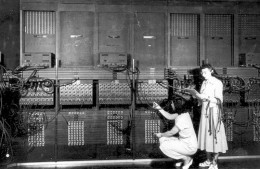Programming: Used to Be A Total Girl Thing

Here is a fun little history lesson care of Annie Lowrey’s Twitter, care of Stanford University’s Clayman Institute for Gender Research, circa 2011, about computer programming circa 1960 (BLOGGING!):
As late as the 1960s many people perceived computer programming as a natural career choice for savvy young women. Even the trend-spotters at Cosmopolitan Magazine urged their fashionable female readership to consider careers in programming. In an article titled “The Computer Girls,” the magazine described the field as offering better job opportunities for women than many other professional careers. As computer scientist Dr. Grace Hopper told a reporter, programming was “just like planning a dinner. You have to plan ahead and schedule everything so that it’s ready when you need it…. Women are ‘naturals’ at computer programming.” James Adams, the director of education for the Association for Computing Machinery, agreed: “I don’t know of any other field, outside of teaching, where there’s as much opportunity for a woman.”
IN FACT,
In the early 1940s, the University of Pennsylvania hired six women to work on its ENIAC machine, which was one of the world’s first electronic computers. These six women, known by contemporaries as the “ENIAC girls,” were charged with “setting up” the ENIAC to perform computation tasks. They are widely celebrated as the world’s first computer programmers.
However, says Ensmenger, the presence of these women did not indicate that managers of the ENIAC project had modern attitudes toward women in the workforce. Rather, managers hired women because they expected programming to be a low-skill clerical function, akin to filing, typing, or telephone switching. Assuming that the real “brain work” in electronic computing would be limited to the hardware side, managers reserved these tasks for male engineers.
The idea that the development of software was less important (and less masculine), than the development of hardware persisted for many years and women continued to work as computer programmers.
It was only in the late ’60s when things began to shift. Hiring practices changed completely, the ads were redesigned, and prestigious organizations were created, all with the intention to send the men a-flockin’.
Apparently the advent of what we think of as the stereotypical “computer geek” emerged out of some of these so-called objective personality profiles used in recruiting. Prospective employees were screened for qualities like, “dislikes activities involving close personal interaction” and “disinterested in people.” And there you have one of the earliest progenitors of the “cultural fit.”
Besides you know, um, general misogyny, racism, classism, etc!
Photo: thekirbster
Support The Billfold
The Billfold continues to exist thanks to support from our readers. Help us continue to do our work by making a monthly pledge on Patreon or a one-time-only contribution through PayPal.
Comments